How D2C Brands Can Offer Omni Experience to Millennials
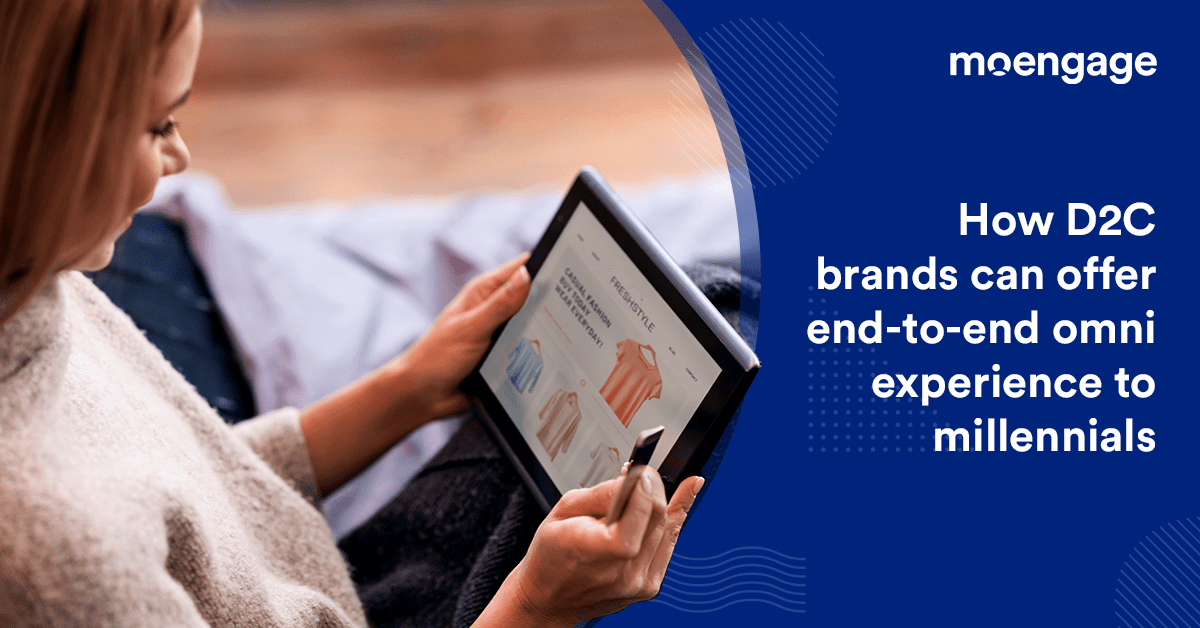
Reading Time: 7 minutes
Fun fact: An estimated $2.5 trillion of annual spending was made just by millennials. And that’s pretty huge.
Now with this growing spending power, millennials easily influence the retail and user experience trends. In fact, in the last few years, millennials have become the primary target buyers for brands worldwide. Millennials grew in an era of computers and smartphones, brands are aware that they are a hyper-connected and tech-savvy segment of buyers.
Unlike the previous generations, they do not shop online or offline entirely. They use hybrid techniques such as researching the products online and then purchasing from a store or vice-a-versa. They prefer omni experience and convenience over everything. This has compelled brands to become omnipresent. Brands have already started to increase their investment in omnichannel to personalize their target audience’s shopping experience.
Bonus Content
|
Apart from being omnichannel, brands have also started to sell directly to consumers (D2C). A report by Diffusion showed that over 81% of US consumers planned to purchase from D2C brands by 2023.
That’s what this article will be covering – D2C offering omni experience to millennials. Here are the few points that will be covered:
- Why do millennials prefer D2C brands over the marketplace?
- Examples of D2C brands that got it right
- How brands can create an omni experience for millennials
What is D2C and what makes it tick with millennials?
Direct to Consumer is a method implemented by brands to directly reach out to consumers without relying on middlemen like wholesalers, retailers, or distributors. These brands take complete control over the marketing, distribution, shipping, etc.
More than 55% of consumers have started to visit brand websites rather than purchasing from a retailer website such as Amazon and Walmart. Even retailers like Target have taken cognizance of this trend and started to bring D2C brands to its store to improve their reputation among the millennials.
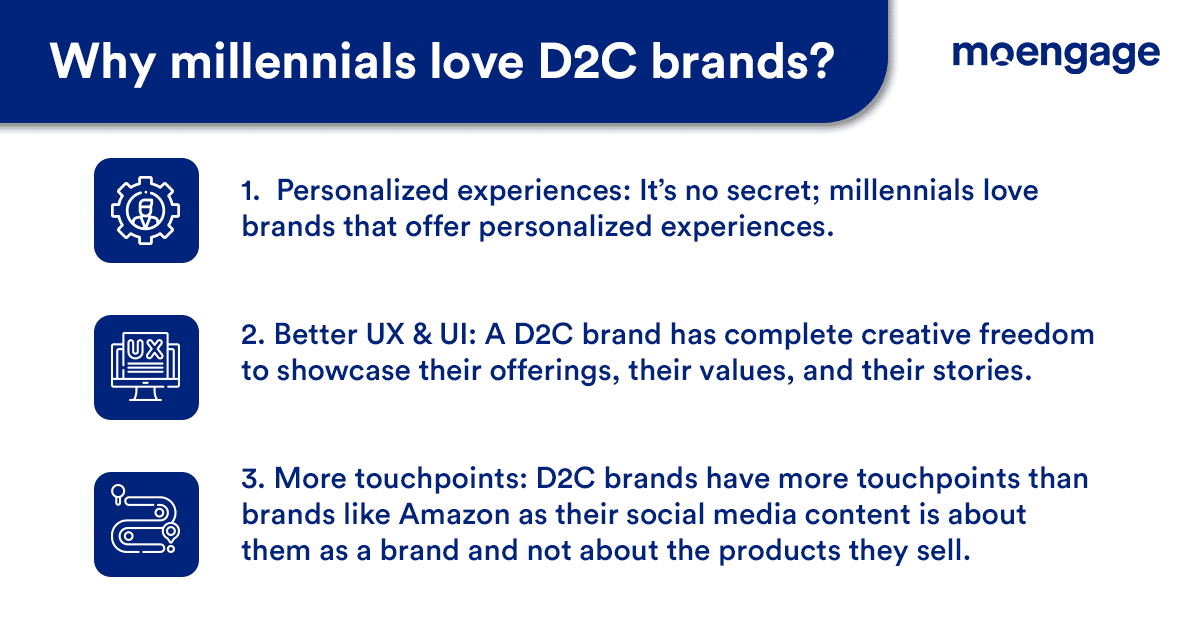
The sudden rise of D2C over retail and e-commerce can be attributed to the following:
- Personalized experiences: It’s no secret; millennials love brands that offer personalized omni-experiences. 80% of the shoppers only purchase from brands that offer personalization. Considering that brands sell directly to consumers in the D2C model, they can collect authentic, first-party data to personalize the consumer’s experience.
- Better UX and UI: Unlike the marketplace websites like Amazon where the products from a brand are listed as a template, a D2C website gives the brand complete creative freedom to showcase their offerings, their values, and their stories. It gives the consumers a glimpse into what the brands stand for and encourages them to shop directly from the website.
- More touchpoints: Although a marketplace like Amazon has aced the omnichannel game by opening retail stores in some places along with e-commerce, D2C brands have way more touchpoints than companies like Amazon. For example, Amazon’s social media content is about Amazon as a brand and not about the products they sell. Of course, given the millions of products they sell, it is impossible to sell them through social media. Here’s where D2C brands score. Considering that millennials are active on social media, they would prefer to purchase from social media platforms directly. Having end-to-end control over the entire process gives D2C brands the freedom to control which touchpoints they want to use to sell as compared to retail and e-commerce brands that do not offer flexibility in touchpoints.
Brands that aced their D2C omni experience game
1. Dollar Shave Club
The first name that crops up when we discuss D2C brands is the US-based Dollar Shave Club. This subscription-based razor company is well known for its witty video that went viral. Within the first three months of that ad, the company received 12,000 sign-ups. Dollar Shave Club was pitted against a giant like Gillette. However, it’s unique content keeping the target audience in mind helped them garner loyal customers. And it’s not just the content.
The Dollar Shave Club leverages data to collect data from different touchpoints and integrate them to create a personalized omni-experience for the consumers. They also pay attention to all the feedback they receive and share them with the whole organization to deliver value. This level of customer-centricity has made them into a billion-dollar company.
2. SimplyCook
The UK’s subscription-based recipe kit service, SimplyCook has been one of the top D2C brands. With an attractive price point and paying great detail to develop diet-specific offerings, SimplyCook managed to differentiate itself from its competitors and build a loyal customer base. What makes them unique is that they develop new recipes by gathering data from customer’s online selections. In fact, they recently opened their retail outlets across Sainsbury stores to reach out to more consumers directly.
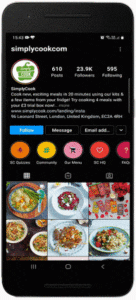
3. Mama Earth
Mama Earth is an Indian D2C brand that manufactures personal care products (earlier they sold only baby care products) that do not contain harmful chemicals. Launched in 2016, the brand became the first company in Asia to get the MadeSafe certification for its toxin-free products. Given the kind of products they were selling, it was important to build trust among their consumers.
The unique part about their strategy was, they did not restrict to using D2C as the sole channel for selling to consumers. They also had a marketplace presence in Amazon and Flipkart, and in retail stores such as Shoppers Stop and Central. Considering that they were themselves digital-natives, they allocated 90% of their marketing budget to digital platforms and influencer marketing and 10% to traditional media. Despite fierce competition from brands like Johnson & Johnson and FirstCry, Mama Earth has managed to cross the Rs 100-crore mark within four years!
How to establish an end-to-end omni experience for your D2C brand?
There is no doubt that D2C brands have started gaining popularity. However, if you want your D2C brand to compete with the marketplace or a retailer such as Amazon and Walmart, you need to create an end-to-end omnichannel presence like them.
Here’s how you can do it.
1. Revisit product offering to include similar high-selling products
Last year, PepsiCo launched two D2C websites – PantryShop.com and Snacks.com to allow consumers to buy goods directly instead of the supplier. While PantryShop.com sold top-selling brands such as Quaker, Gatorade, and Tropicana that cater to the consumers’ home needs, Snacks.com sold 100+ Frito-Lays products to consumers. Both the websites had introductory offers and bundled offers. Gibu Thomas, senior vice president and head of eCommerce at PepsiCo, said that the objective of creating these websites was to offer consumers easy and fast access to their products. Such carefully curated products are unlikely to be found on other retailer websites. If you want to go the D2C route:
- Revisit your product offerings across all channels to find out high-selling products.
- Curate these products and find out how you can proposition them uniquely and exclusively to sell to your consumers.
- Focus on understanding your consumer’s needs and try to address them by customizing your offerings.
2. Be present on social channels and review sites where millennials go before shopping
Millennials use the internet to research products before buying them. They check the brand’s credibility and reviews received from other users before purchasing the products. A recent study revealed that 8 out of 10 millennials do not buy a product before reading its review. So, be present on review sites. Respond to both positive and negative comments in alignment with your branding guidelines. Millennials will give a second chance if they find the brand owning up to its mistake. It builds their credibility. So, respond and do not react to negative feedback. Own up if you have made a mistake.
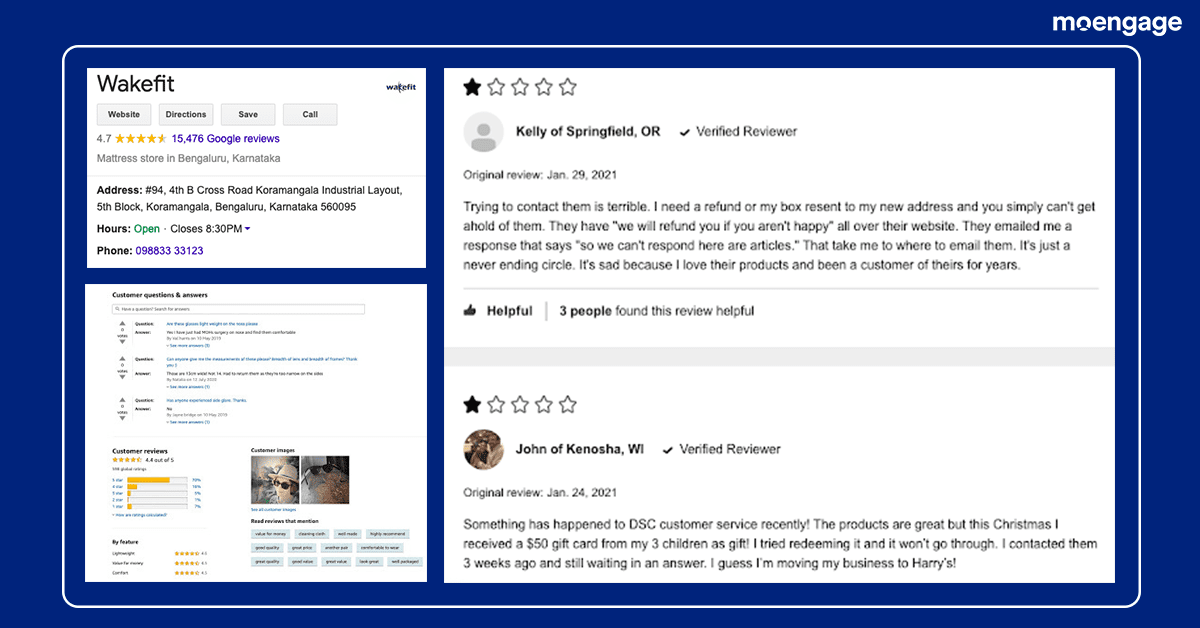
Social media is another touchpoint to use, given that 88% of millennials use it actively. If you want to reach out to millennial buyers directly, you need to be active on social media. Build your persona on social media to create a distinct identity for your brand. Leverage tools such as Facebook Marketplace to sell items to consumers directly in specific geographic areas. Use options such as user-generated content, live videos, stories, and other options to regularly engage with your consumers. Also, invest in social listening tools to understand what’s trending and what consumers are talking about. It will serve as a good base for you to create topical content.
3. Understand the behavior using a customer engagement platform
If you want to personalize the Omni experience of your customer, you must understand their behavior. To truly understand your customer’s behavior, you need to begin with collecting the data of your users from various touchpoints – both offline and online channels. Once you collect the data in your customer engagement platform, you can get a 360-degree view of your customer’s shopping behavior, likes and dislikes, and shopping preferences. You can segment them based on their behavior and build a personalized experience for them. You can also refer to their current and historical data using advanced analytical tools to predict their future needs and prepare for them.
4. Collaborate with influencers to connect with millennials
Millennials prefer to buy from brands that are recommended by their favorite influencers. Influencer marketing can help you to improve your brand awareness and reach a wider target audience. Take the US-based mattress giant Casper, for instance. It reached out to Instagram and Twitter influencers like Kylie Jenner to generate buzz about their mattress. A single post from her doubled the net sales for Casper! If collaborating with an influencer with a high number of followers is expensive, you can collaborate with micro-influencers as happened with Glossier’s case. This digital-first cosmetics brand has been collaborating with micro-influencers to spread the word on platforms like Instagram.
70% of online sales happened due to peer-to-peer reviews by micro-influencers. Influencers add authenticity and a human touch to the brand. Their recommendations can boost sales quickly. So, collaborate with influencers who are well-established names in your industry. However, ensure that they are genuine and align their messaging with your brand’s communication to create maximum impact.
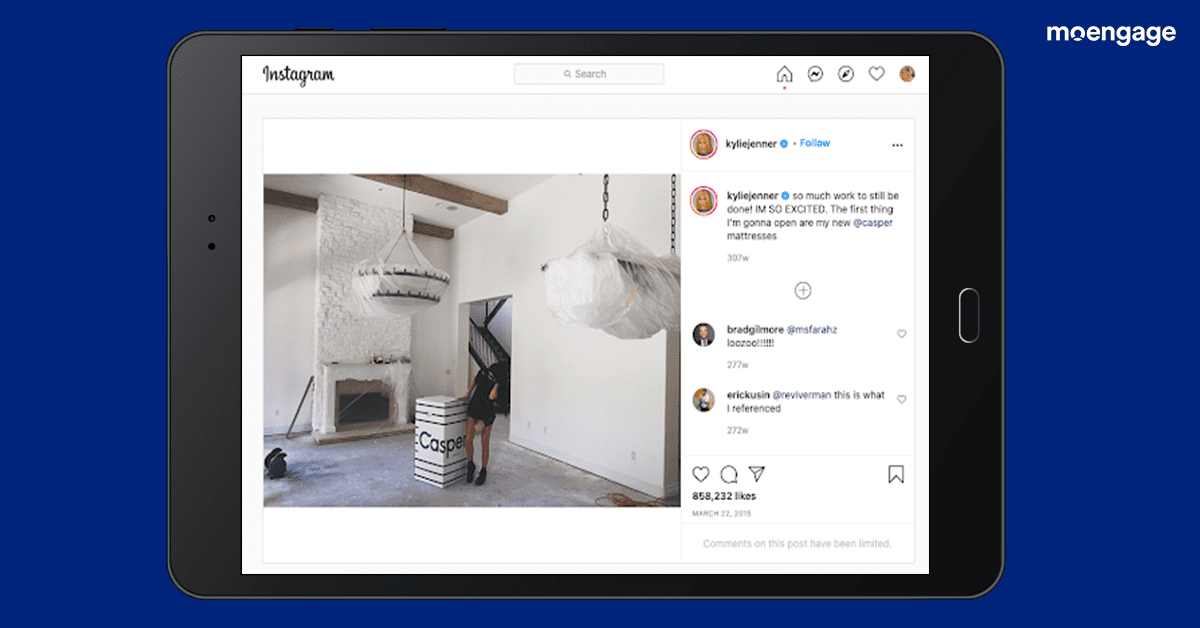
5. Create product videos with compassionate stories instead of typical advertising
Contrary to popular beliefs, 60% of millennials are loyal to brands they like and will repeat their purchase if they are conscious and compassionate about society and the environment’s underlying issues. Unlike traditional advertising where brands talk about themselves, millennials expect the brands to be authentic and stand by the message they profess. To create a lasting impression on the consumer, you must focus on saying compassionate stories. Whatever you choose to do – be it product video or social media content, ensure that it does not talk about your brand but about why you do what you do and how it would benefit society.







